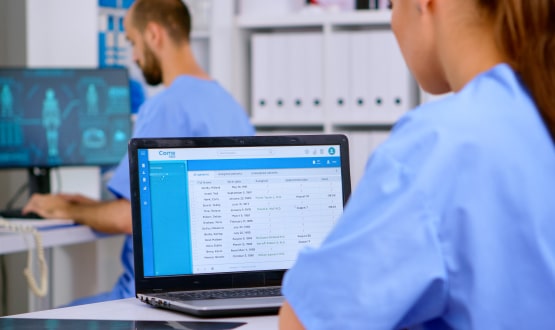Usability: Why EPRs can and should do more
- 17 April 2023

Suppliers of electronic patient records need to escape siloed thinking, come together and improve what they’re offering to clinicians. By Fiona Dawson, director, Mayden
In software, usability is the foundation on which all else is built. A system that is reliable, easy to navigate and with the right level of functionality should be the baseline of what users expect and experience. Healthcare technology should be no different. Unfortunately, this isn’t always the case.
The 2022 NHS EPR usability survey, published last summer, indicated that usability is a priority for clinicians, but that largely, they are underwhelmed. The survey generated thousands of responses and while some suppliers have acted on the feedback, the results have still not yielded much industry discussion. This is a shame: siloed thinking hinders us from sharing best practice. As an industry we need to sit up and listen to the feedback and own it so we can learn and improve.
Mayden was ranked in the 100th percentile for overall experience for NHS mental health EPRs. We scored 80.1% on reliability and speed and 77.6% on functionality compared to the NHS average of 58.1% and 44.3% respectively. But for us, it was just the start. There is always space to improve, and we’ve already made changes based on the feedback we received.
NHS average is a low bar
We are cautiously pleased with our results because, as an industry, the bar is set pretty low in terms of what constitutes good usability. But why is that? No supplier sets out to fall short of expectations. So, what can we be doing collectively to improve as an industry?
There needs to be a shift in mindset, in terms of innovation and competition, to create the right conditions to raise the bar. Many EPRs are languishing in a place which might have been okay in terms of usability 20 years ago but is not fit for purpose now. In a digital age, NHS users understand what good usability should be. This means as a sector we urgently need to come together as a whole, regardless of competition, to ensure people’s expectations and needs are met.
Learn from each other
It is important to use feedback from across the industry to learn and improve. If we aren’t taking accountability to improve, then who’s going to? We need to share what we are doing as suppliers, so we don’t end up with a stagnated and siloed industry.
The national agenda around convergence has centred largely around the acute sector. We argue that this is where it belongs. Although intended to level up EPR provision, it encourages a cookie cutter approach and stifles innovation. This will be further exacerbated if the government’s current ambitious targets for EPR roll outs are going to be met as there will be less scope for customisation and configuration during each deployment. There’s a risk that this will also affect diversity in localised ways of working and ultimately impact usability.
Innovation and continuous improvement
To meet the needs of a changing workforce, evolving models of care and fast-paced technological advancements, we need to take advantage of the opportunities out there to improve. We facilitated a roundtable with CIOs last year and the conversation kept circling back to usability. This is a foundational, basic issue that needs to be addressed. Therefore, EPR suppliers must be accountable for drawing not just on healthcare, but other industry best practices as well to keep ahead of trends and continuously improve.
Let’s not forget that the usability of an EPR has a direct impact on patient safety and patient care. No-one benefits when a patient has to retell their story as they move between clinicians and clinical settings, or because a page is too slow to load.
But this isn’t something that can just be done in isolation. It’s not about suppliers going off and building ‘cool tech’ and then selling ideas back into the care system. As a supplier community we have an opportunity to collaborate around a common goal, and tackle the problems being faced by frontline healthcare professionals using our software. We need to build software that meets the needs and addresses the problems within the sector, but it must also work together.
Invest in training and relationships
Collaboration is important, but there are some things that suppliers can do on their own. We can all look for opportunities to innovate based on customer feedback and improve from where our products are at right now. For Mayden, being a cloud-born solution means we know and understand how to leverage its capabilities, and we use that as a strength. We can cut down time from concept to delivery which means by sharing expertise across services we can make it available to everybody in a very short space of time. From a usability and reliability perspective we can draw on other industry best practice too, learning from and calling on what technology innovators do in other sectors.
The clinicians responding to the survey also cited that they want more of a voice when it comes to prioritising enhancements and updates. That is an open invitation for suppliers to get closer to their users and truly understand their needs. For Mayden, we ensure that the user experience and the user interface are front and centre of our development process, with specialists dedicated to that role. We also encourage ideas from our customers on how we can improve through our innovations hub. This forum helps us to genuinely build a community discussion around how we develop the software in the future.
Due in part to the poor usability of systems, there is sometimes a reluctance from clinical staff to use software and record data. It can be seen as a necessary evil that is distracting them from caring for their patients. At Mayden a core part of our user training is around helping our customers understand the importance of the data they’re recording within the EPR, beyond immediate clinical care. This means clinicians can visualise and appreciate the value of the data they’re capturing so that it can be part of the story.
If people know and understand how the service is working with the right data, and what is used for, it goes a long way to building relationships and understanding. It also helps to drive innovation. Everybody wins.
Monoliths can learn from niche suppliers
A best of breed supplier has a huge advantage in terms of being able to know and understand how our customers work. We have a high level of customer understanding and bring clinical specificity that professionals sometimes need to work efficiently and provide the best possible care. But there are important roles for both the big systems and best of breed providers in the health system – by working together we can provide the best for the healthcare sector as a whole. And ultimately, the best for patients too.
As an industry we have a responsibility to make a change. As patient records become unified, models of care change, and services become more digitally mature we must develop and evolve to better support both clinicians and patients.
As an EPR supplier we recognise that we’re not perfect. This is part of our commitment to continuous improvement. We believe in upholding values which we live and breathe ourselves. We want to ensure the best possible usability which meets the needs of our current customers, but we also want to be part of the continuous resolution and improvement within the sector.





